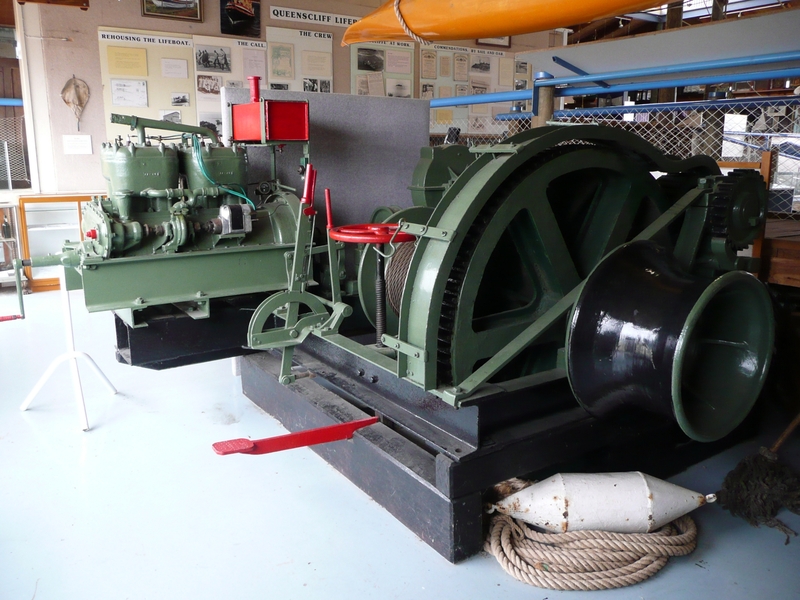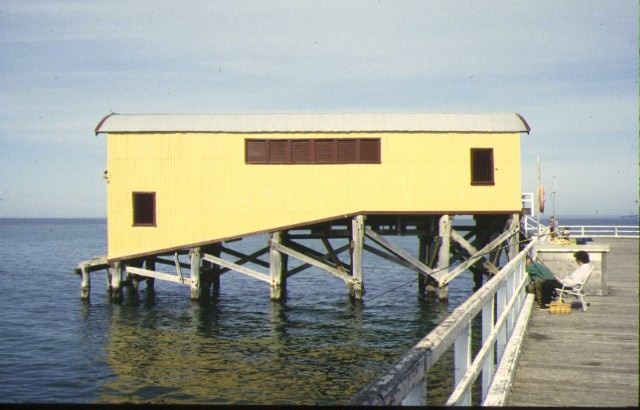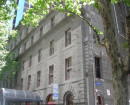QUEENSCLIFF PIER AND LIFEBOAT COMPLEX
SYMONDS STREET QUEENSCLIFF, QUEENSCLIFFE BOROUGH
-
Add to tour
You must log in to do that.
-
Share
-
Shortlist place
You must log in to do that.
- Download report










Statement of Significance
What is significant?
Queenscliff Pier was built between 1884 and 1889, a shelter shed in 1886-87and a new lifeboat shed between 1926 and 1929 to house the newly-arrived lifeboat Queenscliffe. The first jetty at Queenscliff was constructed in about 1856 and was located at the end of Wharf Street. A lifeboat was added soon afterwards and a lifeboat shed in 1860. This pier became known as the Fisherman's Pier. As the town prospered, the increasing use of steamers for pleasure and for carriage of goods created a need for a new pier extending to deeper water. A new pier known as the Steamer Pier was constructed in 1884 to the south of the first pier. John Knox of South Melbourne was the contractor for this pier. This is the pier that remains today. A series of extensions to both piers over the next few years culminated in the early twentieth century with the formation of a completely enclosed boat harbour. The Steamer Pier was extended a year after it was constructed, and again during 1886-7. On the 1886-7 extension to the Steamer Pier, Campbell and Grey constructed a shelter shed, which is the one in existence today. Following an extension to Fishermen's Pier, a new lifeboat shed was built between 1926 and 1929 by D O'Dorward to house the newly-arrived lifeboat Queenscliffe. The lifeboat shed included a slipway with roller, channel, keelway and cradle supplied by Herbert Brookes' Austral Otis Engineering Co., the firm, Ellinston and O'Neill added a petrol engine for the slipway. The lifeboat shed was relocated in 1946 to its current site on Queenscliff Pier (formerly Steamer Pier) and Fisherman's Pier was later demolished. The surviving lifeboat, which is now housed at the Queenscliff Maritime Museum, was the fourth lifeboat to be used at Queenscliff. It is a Watson Class boat built by A. McFarlane and Sons at Port Adelaide and was commissioned into service on 6 March 1926, and officially launched at Queenscliff on 9 April 1926.
How is it significant?
The Queenscliff Pier and Lifeboat Complex is of historical, architectural, aesthetic and technological significance to the State of Victoria.
Why is it significant?
The Queenscliff Pier and Lifeboat Complex is of historical significance for its associations with the lifeboat service, the sea pilot service, the famous bay ferries and paddle steamers. Queenscliff Pier, built between 1884 and 1889 is of historical significance as a symbol of the early bay steamers and the numerous distinguished patrons brought by them from Melbourne to Queenscliff and Point Lonsdale. The pier perpetuates the memory of the Bay Steamer trade and the now demolished Fishermen's Pier. It contains the last lifeboat shed to be constructed over the water in Queenscliff.
The Queenscliff Pier and Lifeboat complex is of architectural significance as a collection of rare surviving intact timber pier structures. The lifeboat shed is of architectural significance as a rare intact example of a jetty mounted lifeboat shed. Few if any of these sheds remain in Victoria. Similarly the barrel shape of the shed roof is an uncommon aspect generally seen only in nineteenth century railway goods sheds. The shelter shed too, with its arched wrought iron truss work and panelled timber interior is a more sophisticated and direct reminder of the bay steamer days. The pier and its buildings are of aesthetic significance as a prominent landmark on the bay representing a bygone era in Queenscliff's history.
The lifeboat is of technological significance as it is the only example of its type known to exist in Australia. It demonstrates boat building and rescue technologies at the time of its construction in 1926.
-
-
QUEENSCLIFF PIER AND LIFEBOAT COMPLEX - History
Associated People:
QUEENSCLIFF PIER AND LIFEBOAT COMPLEX - Assessment Against Criteria
Criterion A
The historical importance, association with or relationship to Victoria's history of the place or object.Criterion B
The importance of a place or object in demonstrating rarity or uniqueness.Criterion C
The place or object's potential to educate, illustrate or provide further scientific investigation in relation to Victoria's cultural heritage.Criterion D
The importance of a place or object in exhibiting the principal characteristics or the representative nature of a place or object as part of a class or type of places or objects.Criterion E
The importance of the place or object in exhibiting good design or aesthetic characteristics and/or in exhibiting a richness, diversity or unusual integration of features.Criterion F
The importance of the place or object in demonstrating or being associated with scientific or technical innovations or achievements.Criterion G
The importance of the place or object in demonstrating social or cultural associations.Criterion H
Any other matter which the Council considers relevant to the determination of cultural heritage significanceQUEENSCLIFF PIER AND LIFEBOAT COMPLEX - Permit Exemptions
General Exemptions:General exemptions apply to all places and objects included in the Victorian Heritage Register (VHR). General exemptions have been designed to allow everyday activities, maintenance and changes to your property, which don’t harm its cultural heritage significance, to proceed without the need to obtain approvals under the Heritage Act 2017.Places of worship: In some circumstances, you can alter a place of worship to accommodate religious practices without a permit, but you must notify the Executive Director of Heritage Victoria before you start the works or activities at least 20 business days before the works or activities are to commence.Subdivision/consolidation: Permit exemptions exist for some subdivisions and consolidations. If the subdivision or consolidation is in accordance with a planning permit granted under Part 4 of the Planning and Environment Act 1987 and the application for the planning permit was referred to the Executive Director of Heritage Victoria as a determining referral authority, a permit is not required.Specific exemptions may also apply to your registered place or object. If applicable, these are listed below. Specific exemptions are tailored to the conservation and management needs of an individual registered place or object and set out works and activities that are exempt from the requirements of a permit. Specific exemptions prevail if they conflict with general exemptions. Find out more about heritage permit exemptions here.Specific Exemptions:General Conditions:
1. All exempted alterations are to be planned and carried out in a manner which prevents damage to the fabric of the registered place or object.
2. Should it become apparent during further inspection or the carrying out of alterations that original or previously hidden or inaccessible details of the place or object are revealed which relate to the significance of the place or object, then the exemption covering such alteration shall cease and the Executive Director shall be notified as soon as possible.
3. If there is a conservation policy and plan approved by the Executive Director, all works shall be in accordance with it.
4. Nothing in this declaration prevents the Executive Director from amending or rescinding all or any of the permit exemptions.
5. Nothing in this declaration exempts owners or their agents from the responsibility to seek relevant planning or building permits from the responsible authority where applicable.
Exterior
*Minor repairs and maintenance which replace like with like
* Removal of any extraneous items such as air conditioners, pipe work, ducting, wiring, antennae, aerials etc, and making good.
* No permit is required for maintenance of cradle and winch to ensure their continuing operation.
* No permit required for works related to continuing operation of the slip.
* No permit required for storage of material on site, provided that it does not put the registered structures at risk of damage.
* No permit is required for any emergency works relating to the substructure and superstructure of the pier.
Interior
Painting of previously painted surfaces provided that preparation or painting does not remove evidence of the original paint or other decorative scheme.
* Removal of paint from originally unpainted or oiled joinery, doors, architraves, skirtings and decorative strapping.
*Installation, removal or replacement of electrical wiring provided that all new wiring is fully concealed and any original light switches, pull cords, push buttons or power outlets are retained in-situ. Note: if wiring original to the place was carried in timber conduits then the conduits should remain in-situ.QUEENSCLIFF PIER AND LIFEBOAT COMPLEX - Permit Exemption Policy
The main importance of the Queenscliff Pier and Lifeboat Complex lies in its intactness as a complex, including pier, shelter shed, lifeboat shed lifeboat and machinery. All of these elements are of prime importance and should be retained as a complex. The setting and understanding of these buildings as a whole should be protected. The pier, shelter shed and lifeboat shed are all rare and particularly intact examples of their type. They are important for their representative nature in form and interior/exterior detail. Maintaining the picturesque setting of the pier should be taken into account when considering a permit application.
-
-
-
-
-
LATHAMSTOWE
 Victorian Heritage Register H1052
Victorian Heritage Register H1052 -
PILOTS COTTAGES
 Victorian Heritage Register H1618
Victorian Heritage Register H1618 -
ROSENFELD
 Victorian Heritage Register H1134
Victorian Heritage Register H1134
-
'Lawn House' (Former)
 Hobsons Bay City
Hobsons Bay City -
1 Fairchild Street
 Yarra City
Yarra City -
10 Richardson Street
 Yarra City
Yarra City
-
-












